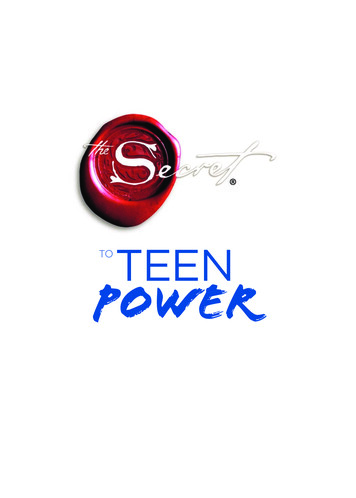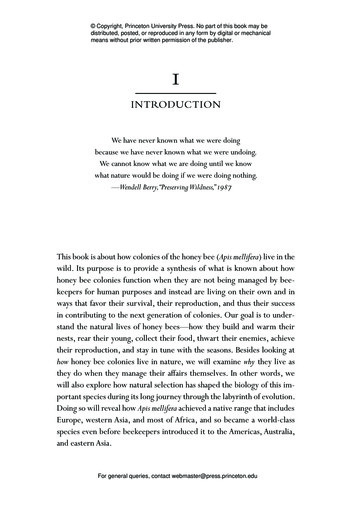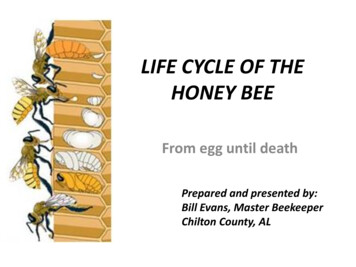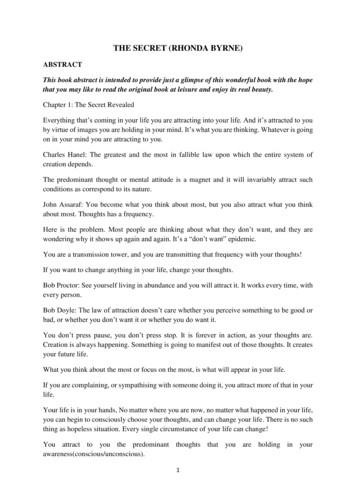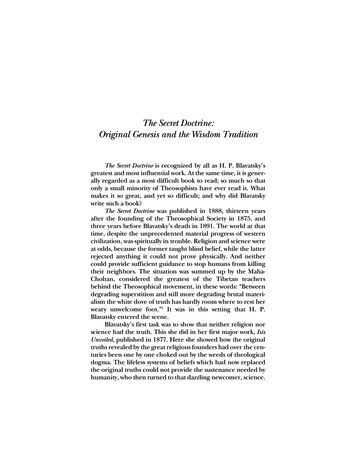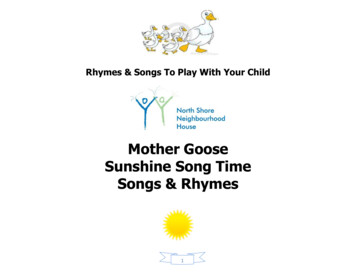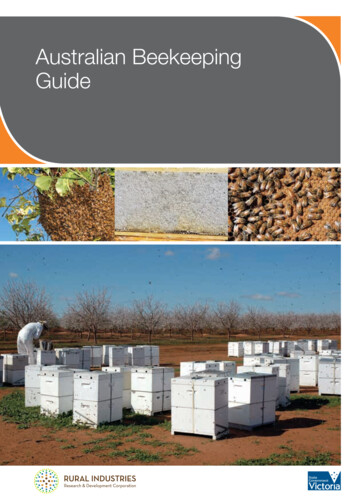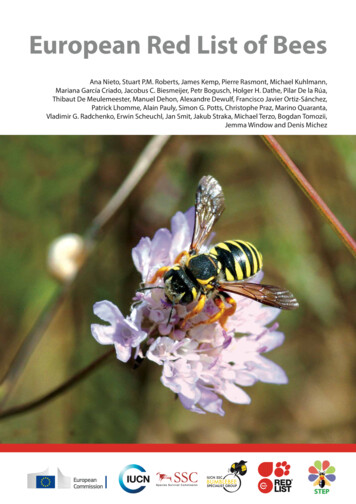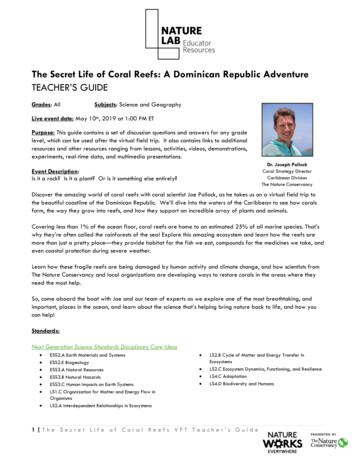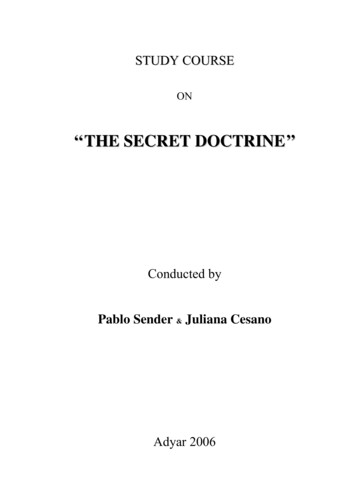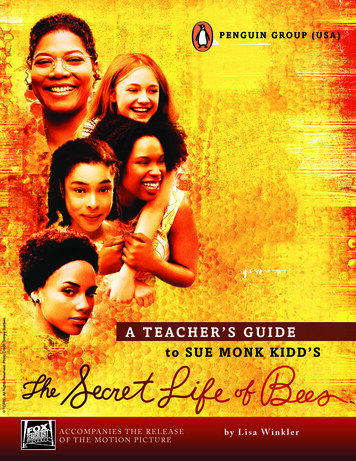
Transcription
TCFFC. All Rights Reserved. Photo Credit: Sidney Baldwin.PENGUIN GROUP (USA)A TEACHER’S GUIDEto SUE MONK KIDD ’ SAC C O M PA N I E S T H E R E L E A S EOF THE MOTION PICTUREby Lisa Winkler
SYNOPSISThe Secret Life of Bees, set in the American South in 1964 amidracial unrest, tells the coming-of-age story of Lily Owens, awhite 14-year-old girl who is searching for the truth about herdeceased mother. She lives on a peach farm with her cruelfather, T. Ray, who tells Lily that she accidentally shot hermother, Deborah, when she was four.Lily accompanies the family’s black housekeeper, Rosaleen, totown to register to vote. Taunted by white men, she spills thecontents of her snuff jar on their feet, is beaten, taken to jail,and later to the hospital. T. Ray reacts by punishing Lily,prompting her to runaway. Back with Rosaleen, she heads toSouth Carolina to investigate a picture of her mother’s of ablack Madonna with the words “Tiburon, SC” written on theback. In a store she sees jars of honey with the same picture,leading her to the black Boatwright sisters—August, June, andMay—who raise bees and harvest honey, live in a bright pinkhouse, and practice their own religion. TCFFC. All Rights Reserved. Photo Credit: Sidney Baldwin.Though the sisters provide a loving home for Lily, she’s reluctantto ask about her mother. She befriends Zach, a black boy whoworks with the bees, and witnesses additional examples of racismin the town. Eventually, she learns the truth about her mother.ABOUT THE AUTHORSue Monk Kidd listened to her father’s stories growing up inthe tiny town of Sylvester, Georgia. Teachers encouraged herto write her own stories and keep journals. Two books whichshe read at the age of fifteen—Thoreau’s Walden and KateChopin’s The Awakening—had a deep impact on her.She graduated from Texas Christian University in 1970 with adegree in Nursing, working throughout her twenties as a registered nurse on surgical and pediatric hospital units, and as acollege nursing instructor. She met and married Sanford Kidd,a graduate student in theology, and had two children. The pullto writing returned, and she took writing classes. She soonbegan a career as a freelancer, writing personal experience articles, and found immediate success.Her first book was a spiritual memoir describing her adventinto contemplative Christian spirituality, God’s Joyful Surprise(Harper 1988). Her second book, When the Heart Waits(Harper 1990), recounts her spiritual transformation. TheDance of the Dissident Daughter (Harper 1996) explores herinterest in feminist theology.She enrolled in a graduate writing course at Emory University,and also studied at Sewanee, Bread Loaf, and other writers’conferences. In 1997 she began writing her first novel, TheSecret Life of Bees. Her second novel, The Mermaid Chair(Penguin 2005) explores a woman’s pilgrimage to selfbelonging, and the inner life of mid-life marriage.Sue serves on the board of advisors for Poets & Writers, Inc.and is Writer-in-Residence at The Sophia Institute inCharleston, SC. Today Sue lives beside a salt marsh nearCharleston.Text adapted from www.suemonkkidd.comA HISTORICAL OVERVIEWThe Secret Life of Bees is set against the backdrop of the CivilRights Movement in the tumultuous summer of 1964. Minoritygroups in America, especially blacks (African-Americans),believed they were being denied the basic human rightsprovided for other American citizens (namely, whites) by theU.S. Constitution, through the legacy of slavery and racismthat accompanied the formation of this country. The assassination of President John F. Kennedy in 1963 fueled fears thatthe civil rights work he initiated for American minorities wouldbe lost. Yet in his first address to Congress, Lyndon BainesJohnson, the new President, urged for the passage of a civil rightsbill that would further the progress made under Kennedy.The original purpose of the congressional bill, which becamelaw as the Civil Rights Act of 1964, was to provide protectionfor black men from discrimination based upon race, and was2A T E AC H E R ’ S G U I D E T Oexpanded to protect women from discrimination as well.Under this act, racial segregation and the infamous “Jim Crow”laws were declared abolished.When the Civil Rights Act passed, as illustrated in the story,many whites were angered by it, and continued to treatAfrican-Americans cruelly. Despite the action and progressaddressed in the new laws, racial tensions mounted. Racismpersists as a deep root in American society, despite politicalmovements and social change.Other events make the 60s a compelling time in Americanhistory. The escalation of and subsequent protests against theVietnam War; the continuation of the Cold War, manifestedthrough the race to conquer space; and the changes in popularculture—rock and roll, the sexual revolution and the overall antiestablishment atmosphere—contributed to this volatile period.P ENGUIN GROUP (USA)
INTRODUCTION TO THE STUDY GUIDEThe Secret Life of Bees intertwines historical events with a studyof honey bees. Before each chapter, Monk Kidd includes a factabout bees’ life cycles or honey production, taken from variousresources she lists at the end of the book. Pre-reading activitiescould include in-depth research of the history and politics ofthe time, and about bees and bee keeping. Many resources areavailable in libraries and on the internet.The study guide is organized chronologically by chapter andincludes vocabulary words, references to explain to students, orto have them research, and quotations.The quotations can be used as writing prompts or to initiatediscussion. You can assign the discussion questions and writingprompts as students read the novel, or as a final assessment.The themes and symbolism can be discussed during or afterreading. They provide opportunities for students to makeconnections to other works of literature, movies or theaterthey’ve seen, historical and current events, or their own lives.The general reading response topics can be used for journalwriting. The creative projects and the activities extend thereading experience, promote critical thinking, and bring thenovel to life for students.Vocabulary ActivitiesThere’s a selection of vocabulary words identified for eachreading section. You may want to either add to this list ordecrease it depending on your students. You can decide whetherto introduce vocabulary before reading the section, during, orafter. Vocabulary activities could include looking up definitions, writing original sentences, finding the words on thepages and making a guess based on context clues and so on.You can quiz students on each section of words, assign them towrite their own stories with vocabulary words, or play gamesto reinforce word meanings.Quotations & ReferencesAs you read each chapter, look for sections that might lendthemselves to readers’ theater, acting out, or debates. You canhave students do mini-research projects on the various references from the novel that are mentioned in the guide. Studentscan present their findings to the class in the form of oralreports. The quotations can be assigned as writing topics orused to spur classroom discussion.ThemesThe book presents many opportunities for discussing themes withstudents as they read the novel and at its conclusion. Themesare also good sources for essay writing, and making readingconnections.The major theme, as expressed in the title, comes from August’sstatement: “Most people don’t have any idea about all thecomplicated life going on inside a hive. Bees have a secret lifewe don’t know anything about” (148). Throughout the novel,the reader learns how most characters are not what they seemon the surface. Secrets and secret lives are major themes.Other themes to explore include: Coming of ageSearch for identityRelationships with parentsResilience of the human spiritMan’s inhumanity to manDiscrimination, prejudice, bigotry, class structureLiteracy—the role of writersHow death gives way to life TCFFC. All Rights Reserved. Photo Credit: Sidney Baldwin.3A T E AC H E R ’ S G U I D E T OP ENGUIN GROUP (USA)
SymbolismThe Bee HiveThroughout the novel, Kidd builds on the hive and bees as ametaphor of life. Bees represent people working together in asociety, which is represented by the hive. The queen, or motherfigure, presides over the hive. August shows Lily how the beesbecome confused when the queen bee dies; however, if shereplaces her with a new queen bee soon enough, they will beokay. Like the worker bees, Lily has been confused andsaddened by the death of her mother. Through the intervention of the women in this novel—particularly Rosaleen andAugust—Lily is saved.Our Lady of Chains Statue TCFFC. All Rights Reserved. Photo Credit: Sidney Baldwin.The statue of Mary is symbolic on two levels. On one level, it isan obvious representation of The Blessed Mother, an important Catholic icon. In this sense, the women are not praying tothe actual statue, but to whom it represents. On another level,this statue (or Mary) represents all women’s need for amother—for guidance and strength. Our Lady of Chains ismother and queen to the women in the novel. Mary isfrequently called “The Queen of Heaven” and as their “queen,”Mary provides a guiding force for the women. As August tellsLily, Mary is also a source of strength, which can be foundwithin.General Reading Response TopicsThe Whale PinThe whale pin that T. Ray gave to Deborah when they weredating is a symbol of T. Ray’s complexity. August tells Lily thatT. Ray treated Deborah like a princess. Lily is shocked to hearthat T. Ray was not always a cruel man. Lily wears the pinwhen she confronts T. Ray. During this confrontation, T. Raychanges. T. Ray momentarily experiences the rage and sadnesshe felt when Deborah left him. He acquiesces to Lily’s demandto stay with August. Lily has always assumed T. Ray is a meanman by nature; she never considered why he might be that way.The whale pin illustrates that, at one time, he was kind andgentle. But T. Ray’s heart was broken and he has been bitterever since.One way to assist students in finding more meaning in theirreading is through response journals. You can assign topics orallow students to select their own. This could be a ten-minuteactivity at the end of class.1. Connections: text to text, text to self, text to the world.Compare and contrast your book to others you’ve read, to situations or people in your own life, to events in history or thenews.2. Characters: Do you like the main characters or not? Why?Do you have any advice for them? Comment on the narration.Who’s telling the story?3. Social question: Look for race, gender, or class inequalitiesand injustices. Who has the power in the story and how is itused? What do you think? Does it make you think or feel differently about those of another race or gender than your own?4. Setting: Is it realistic? Does it fit the story?5. Dialogue: Is it realistic? Can you “hear” the characterstalking? Could you change the dialogue? If you changed thedialogue, how would it change the story?6. Emotions: How were you emotionally involved in thestory?7. Literary devices: How does the author use flashbacks andforeshadowing? Is it effective?8. Themes: To what extent is The Secret Life of Bees a moralitytale?9. Ending: Would you have liked the book to end differently?How?4A T E AC H E R ’ S G U I D E T OP ENGUIN GROUP (USA)
CHAPTER 1VocabularyPresumptuous, 2Insomniac, 3Orneriness, 3Cowlick, 9Mercantile, 11Imbecile, 11Carousing, 12Smirking, 13Oblivious, 21Impersonation, 31Sashaying, 32Unperturbed, 32Recoil, 326. Lily hides her mother’s things in a secret hiding place. Havestudents write about their own secret hiding places—what dothey put there? (14)7. “I sat on a Coke crate and watched pickups zoom by till Iwas nearly poisoned with exhaust fumes and boredom” (15) .This sentence juxtaposes a concrete and an abstract noun. Seeif students can write their imitations of this sentence, creatingthe juxtaposition of a concrete and abstract noun.8. On page 16, Lily mentions how she wrote “My Philosophyof Life” for a school assignment. Based on what you know sofar, what would be her philosophy? Think about her philosophy and how it changes in the novel. Students can write abouttheir own philosophies of life.9. While Lily’s working at the peach stand she passes the timeby making up poems. How can a place you hate inspire writing?What are ways to pass the time if you’re bored? How canimagination help pass time? (16)10. On page 18, T. Ray asks Lily what she remembers abouther mother’s death. She was four at the time. What are students’earliest memories? How early do we have the capacity toremember? Have students support their opinion.11. Lily’s birthday is July 4. She feels ignored because it falls onIndependence Day. Have students write about their own birthdays—many may have birthdays on holidays—and if they’ve everbeen disappointed by one, or have felt that they’re not noticed. TCFFC. All Rights Reserved. Photo Credit: Sidney Baldwin.Quotations“People who think dying is the worst thing don’t know a thingabout life” (2).Writing Prompts & Discussion Topics1. Lily plans how it will be when she sees her mother in paradise. She dreams that her mother will fix her hair. Most people,or at least girls, can relate to a hair story. Have students writeabout their own hair and any stories they remember (3).2. Many people can remember a person or a place by scent.Lily remembers her mother’s scent (6). Students can writeabout how they associate different smells with different peopleor places.12. Lily wants a charm bracelet for her birthday. Students canspeculate about what she would want on her charm bracelet ordesign one as an art project. They could design one of theirown to represent themselves.13. Page 22 offers some lovely images of the bees. Havestudents write a poem using some of the words.14. What do we learn about T. Ray on page 24 when he tellsLily: “You act no better than a slut.” How does he punish her?15. Discuss the metaphor about Lily’s mother on the bottomof page 24: “Like she was bits and pieces of insulation moldedagainst my skin, helping me absorb all his meanness.”16. On page 26, Lily realizes she has to leave her father. Whatdoes this say about her? Have students write about a time theyfelt they needed to run away.17. How does the minister react to seeing Rosaleen in hischurch? What does this tell us about the time period? Whatdo students think of his response?3. Have students write about an argument between theirparents (7).18. On page 32, the mob quickly becomes a riot. Discuss howa small event can trigger violence.4. Many students can relate to an argument they might havehad with their parents about clothing or felt peer pressure tohave certain things. How does this relate to Lily’s experiences?(9)19. Page 33, the last paragraph provides a great image for a writingprompt. How can a small sound fall across the whole world?5. Have students bring in old photographs and write stories toaccompany them (12).Sophia Loren, 9Khrushchev, LBJ, 1964, Civil Rights Act, 20Martin Luther King, Jr., 215A T E AC H E R ’ S G U I D E T OReferencesP ENGUIN GROUP (USA)
CHAPTER 2VocabularyWriting Prompts & Discussion TopicsDeliberate, 38Brazen, 38Beseeching, 40Pious, 44Blaspheme, 441. What does T. Ray tell Lily about her mother? (39) How doyou think she feels?2. Why does Lily say “I was thinking how much older fourteenhad made me. In the space of a few hours I’d become fortyyears old” (43). What occurred to make her feel this way?What makes children grow up too fast?3. Monk Kidd describes the Sylvan Memorial Hospital with alist of smells (45). How can smell characterize a place?4. The Supremes song that Lily hears makes her think: “There’snothing like a song about lost love to remind you how everything precious can slip from the hinges where you’ve hung it socareful” (50). Have students write about a song that resonateswith them, reminds them of something, etc. Play a tape of thesong to introduce them to the time period.5. “Loss takes up inside of everything sooner or later and eatsright through it” (55). Discuss this quote, its relevance to thenovel so far. Have student connect to their own lives.Reference TCFFC. All Rights Reserved. Photo Credit: Sidney Baldwin.The Supremes’ Where Did Our Love Go?, 50CHAPTER 3VocabularyReferencesSpeculating, 63Consternation, 64Shakespeare, Thoreau, Eleanor Roosevelt, 57Quotation“I realized it for the first time in my life: there is nothing butmystery in the world, how it hides behind the fabric of ourpoor, browbeat days, shining brightly, and we don’t even knowit” (63). What is Lily referring to? How does this connect toyour own life? What is meant by “mysteries of the world?”Dixie, Confederate Flag, Fort Sumter, hula hoops, Goldwaterfor President signsVietnam, Castro, Malcolm X, Saigon, 65The Beatles, 66CHAPTER 42. Students can research the process of making honey and doresearch on bees (77).VocabularyCorrugated, 71Meander, 80Writing Prompts & Discussion Topics1. Kidd describes August Boatwright with images of food andcandy. Students can try describing someone using food (71).3. Every teen wishes to be normal; Lily is no exception (79).Have students write about their own attempts at being normaland fitting in.ReferenceChurch bombing in Birmingham, 4 girls killed, 806A T E AC H E R ’ S G U I D E T OP ENGUIN GROUP (USA)
CHAPTER 53. On page 92, August teaches Lily about “bee yard etiquette.”How does she compare the world to bees? This could bewritten into a poem or a song. Students could extend the metaphor with sayings of their own.VocabularyConsolation, 82Ambrosia, 84Naïve, 84Unassuming, 85Bona Fide, 85Bristled, 86Revelation, 87Righteous, 87Indignation, 87Eclectic, 90Immunity, 92Etiquette, 924. What caused April to become “deflated about life?” (97)What does this mean?Writing Prompts & Discussion Topics1. Honey making, bees, and bee keeping are central to thenovel. Students can write their own honey songs (83), collectrecipes, and make posters advertising honey (84).2. On page 87, June says: “But she’s white, August.” Lily overhears her. Why is this unusual for Lily to hear? Discuss howwhite people can experience discrimination.5. May Boatwright’s heart can’t bear all the pain and sorrowsin the world, so in order to cope, she writes them down andhides them in her “wailing wall” (97). Start a discussion withstudents about how they deal with painful things, and havethem write down things about the world they wish they couldchange. Then create your own “wailing wall” in your classroom(a secure box or billboard) for the students to release theirtroubles to.Quotation“The world will give you that once in a while, a brief time-out;the boxing bell rings and you go to your corner, where somebody dabs mercy on your beat-up life” (82).ReferencesWalter Cronkite, 88CHAPTER 6VocabularyIngenious, 104Deliverance, 107Solace, 109Writing Prompts & Discussion Topics1. Have students design and create hats for the Daughters ofMary (106). They could use recyclable materials and artsupplies.2. On page 112, Walter Cronkite reports that a rocket will besent to the moon. Students can research the space race, orwrite to NASA for information, as ways to extend thereading. TCFFC. All Rights Reserved. Photo Credit: Sidney Baldwin.7A T E AC H E R ’ S G U I D E T OP ENGUIN GROUP (USA)
CHAPTER 7VocabularyIncessantly, 120Consignment, 125Writing Prompts & Discussion Topics1. Lily’s friendship with Zach is growing. Discuss how probablea friendship or a romance could be between a white girl and ablack boy during this time period in the American South.2. On page 130, Lily sees August reading Jane Eyre. Could thisbe symbolic? Students might want to know who Jane Eyre isand about the story.3. “Lily, I like you better than any girl I’ve ever known, but youhave to understand, there are people who would kill boys likeme for even looking at girls like you,” Zach tells Lily on page135. What does this comment say about the social climate ofthe times? What other stories do students know about whereyoung lovers face prejudices from society?ReferencesFats Domino, Miles Davis, 117. Play samples and/or showfilm clips of their music to help students understand the discussion between Lily and Zach.The Fugitive, 123 TCFFC. All Rights Reserved. Photo Credit: Sheryl Nields.CHAPTER 8VocabularyHigh-caliber, 137Kamikaze, 151Writing Prompts & Discussion Topics1. On page 137, Lily decides if she could have picked a monthto be named for, she’d have selected October and gives herreasons. Asking to students to do this would be a fun writingassignment. It could be a persuasive essay: Why I’d like to benamed ; or any other type of writing. Students coulddescribe how they’d spend their special month.2. Lily’s list of what she loves can be written as a list poem.Students can write their own lists of what they love (139).What does Lily’s list say about her? Students could write theselists for other characters.3. Lily saved a Coke bottle from Massachusetts “as a tribute tohow far something can go in life” (139). What does she mean?Why is she attached to something like an old Coke bottle?4. Students can write their own “tall bee tales,” like the one onpage 143.5. What does August mean when she says: “the hardest thingon earth is choosing what matters” (147).6. Why does Lily call her father? Is she homesick? Worriedabout him? What did she expect to gain from talking to him?(159-160)7. On page 162, Lily writes an acrostic poem about her father.Have students write an acrostic about themselves or someonethey know, or other characters in the book.8. Though writing her letter to T. Ray brought Lily some relief,it didn’t bring her any joy. Sometimes writing a letter and notsending it can bring relief. Students can write letters to peopleor themselves and not send them but as a way to express feelings they can’t say.Reference TCFFC. All Rights Reserved. Photo Credit: Sidney Baldwin.8A T E AC H E R ’ S G U I D E T OJack Palance, 154P ENGUIN GROUP (USA)
CHAPTER 92. On page 173, Lily asks May if she ever knew a DeborahFontanel (Lily’s mother).VocabularyAmbitious, 165Magnitude, 172Oblivious, 173Cunning, 173Crevice, 176How is May’s response a turning point in the story? How doesLily react to her answer? Why does May suddenly need to goto her wailing wall?Writing Prompts & Discussion Topics1. On page 170, Lily thinks: “Every human being on the faceof the earth has a steel plate in his head, but if you like [Lisa,double check quote, is it “if you look”?] down now and thenand get still as you can, it will slide open like elevator doors,letting in all the secret thoughts that have been standingaround so patiently, pushing the button for a ride to the to.The real troubles in life happen when those hidden doors stayclosed for too long.”What does Lily mean? What is she referring to in her life?How can students connect this quote to their own lives?3. Lily tells Zach: “I’ll put it in a story.” She shares her thoughts:“It’s something everybody wants, for someone to see the hurtdone to them and set it down like it matters” (185). Whatprompted her to say this? How are events in society affectingher personal life?ReferencesNiagara Falls, people going over in barrels, 165Civil Rights Act, 166American Bandstand, Dick Clark, 175Ed Sullivan, 185CHAPTER 10observe rituals regarding death and burial. Why are theyimportant? What do they do to the bee hives? (206) Why dothey do this?VocabularyAnguish, 199Vigil, 200Hovering, 202Ritual, 205Induction, 206Catacombs, 206Taffeta, 2112. Why do they eat seeds during the vigil? (207) What canseeds be a symbol of?Writing Prompts & Discussion Topics1. After May commits suicide, August announces that they’llbe sitting vigil. Discuss how different cultures and religions3. On page 209 Lily decides “everybody being colorless” wouldbe better than trying to have whites get along with blacks.”Discuss: at what age do children become aware of differences?Of races?ReferenceAristaeus, Greek myth, 206CHAPTER 11VocabularyDillydallying, 214Industrious, 219Sauntered, 224Quiver, 225Taunting, 239Writing Prompts & Discussion Topics1. How is Zach changing? Why is he changing? (216)2. Lily’s and August’s favorite dessert is peanuts in a Cokebottle. Students can write about their favorite desserts andhave a dessert party. Or have them try peanuts in Coke!3. What is Mary Day? (220) How do the Boatwright sisterscelebrate it and what is its significance in the novel?4. What does Zach mean when he tells Lily: “That jail cell isgonna make me earn grades higher than I ever got” (230).ReferencesFlorida Everglades, 2199A T E AC H E R ’ S G U I D E T OP ENGUIN GROUP (USA)
CHAPTER 12Writing Prompts & Discussion Topics1. On page 237, August tells Lily about her mother, who shetook care of as a child. She mentions she hid in a tree to avoidhaving to memorize Robert Frost’s poem, “Stopping by theWoods on a Snowy Evening.” Lily remembers learning thesame poem. Share the poem with students and discuss thethemes that connect to the novel.2. When Lily learns the truth about her mother, she thinks,“Knowing can be a curse on a person’s life. I’d traded in a packof lies for a pack of truth ” (255). How is she coping with thisknowledge? What is she feeling now?3. August tells Lily, “There is nothing perfect, there is onlylife” (256). Discuss and have students respond in writing,giving their own examples of life’s imperfections.CHAPTER 13Writing Prompts & Discussion Topics1. In this chapter, Lily confronts many of her feelings abouther mother leaving her. Students may be able to write aboutbeing left, about broken families, etc. These can be privatejournals.2. Describe the ritual of Mary Day (268-269). How does theritual help Lily overcome her anger?3. August gives Lily some things she had kept that belonged toLily’s mother. Among them is a mirror, a hairbrush, and avolume of William Blake’s poems. Lily finds a poem that hermother had underlined. How does seeing something thatbelonged to a relative help a person know that relative?4. How does seeing the photograph of her mother holding hermake Lily feel? (275) How is this a sign to Lily?CHAPTER 14VocabularyDemoralized, 286Melancholy, 287Skittish, 291Resolve, 298Perpetually, 301Writing Prompts & Discussion Topics1. What is the significance of Rosaleen getting a voting card?(281)2. What is Zach’s news? (283) How probable is it this wouldhave occurred?3. What does August mean when she tells Lily she has to “finda mother inside yourself ” (288). What are the characteristicsAugust tells Lily she needs?4. Why does T. Ray call Lily “Deborah”? (294) What hashappened to him?5. What does Lily mean when she says she believes in the“goodness of imagination”? (300)10A T E AC H E R ’ S G U I D E T O TCFFC. All Rights Reserved. Photo Credit: Sidney Baldwin.ReferencesGoldwater/Humphrey election, 283Nat King Cole, 285P ENGUIN GROUP (USA)
AFTER READING ACTIVITIESExtending the reading experience for students, through acreative project or dramatic production, makes the reading morememorable and empowers students to have some ownership oftheir work. Many activities can be done in small groups.8. Write interview questions for the author and /or for the maincharacters. Pretend you’re a talk show host and have invitedthe characters to speak. Stage the show before the class.1. Write a diary of one of the characters. Tell his/her secretthoughts, motivations, history, ideas for the future, and thoughtsabout others. For example, write Deborah’s diary explainingwhat really happened the day she died.10. Listen to some music of the Civil Rights era. Some singersinclude: Marian Anderson, Odetta, Peter, Paul and Mary,Mahalia Jackson and other folk singers. Study the lyrics andthemes that were prevalent. Select music to accompany differentscenes from the novel, and explain why each song representsthat particular scene. Or, compose an original song(s).2. Rewrite part of the novel in poem or song form.3. Pretend you’re one of the characters. It’s 20 years from theend of the novel. Write a letter to another character in thebook about what you’ve been doing with your life. For example,does Lily ever see her father again?4. Write a series of letters between any two characters.5. Write a letter to the author about what you think about thebook. (Mail or email the letter)6. Based on research, write news articles or create a newspaperarticle about a section of the novel. Create a timeline of worldevents.7. In a group, select a chapter or scene to dramatize. Write ascript, design costumes and props, and perform for the class.This can also be done as Readers Theater.9. Write a sequel (or the next chapter) to the novel.11. Choreograph a dance for a particular scene.12. Create a mural depicting a chapter or scene from the novel.Or create collages of characters’ personalities using words andimages from magazines.13. August lived in Richmond, Virginia, during the 1920s and1930s. Research Richmond during these times and then writea story of August’s life with Deborah, Lily’s mother.14. Research the mythology of Black Madonnas and showhow Monk Kidd weaves legend into this novel.15. How are the words and teachings of Martin Luther King,Jr., reflected in this novel?16. Research an artist of the sixties. Based on the artist’s style,develop a portfolio of illustrations from this novel.17. Lily Owens cherishes a box with the few remaining thingsthat belonged to her mother. Have students bring in some oftheir favorite things, or things that represent who they are, andhave them place in a box to either decorate as a keepsake, orbury as a time capsule. Students should discuss why they chosetheir items.18. Cook Off or Bake Off: Make honey recipes inspired byThe Secret Life of Bees and bring in as a treat for everyone. Youcould post the recipes on your school website! In the process,lea
Secret Life of Bees. Her second novel, The Mermaid Chair (Penguin 2005) explores a woman’s pilgrimage to self-belonging, and the inner life of mid-life marriage. Sue serves on the board of advisors for Poets & Writers, Inc. and is Writer-in-Residence at The Sophia Institute in Charleston,
